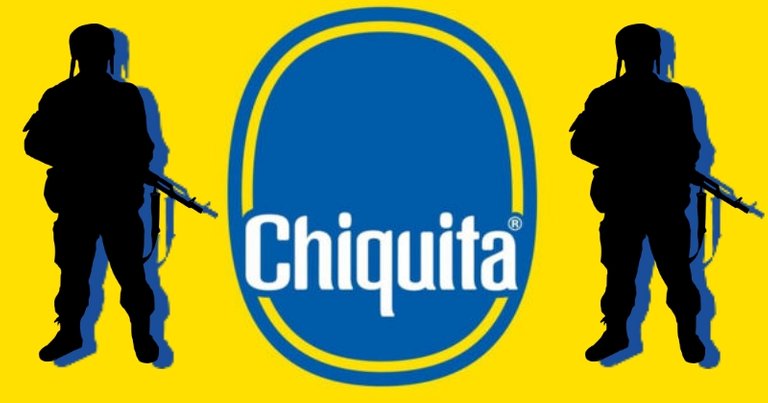
Banana Republic
Definition:
A small country that is economically dependent on a single export commodity, such as bananas, and is typically governed by a dictator or the armed forces.
Chiquita
For more than 100 years Chiquita has been bringing bananas to the world as a joyful and family-friendly brand, instantly recognizable through the iconic Blue Sticker and Miss Chiquita.
https://www.chiquita.com/
This is the rosy, sanitized and consumer-friendly image the Chiquita brand would like the world to believe. A squeaky-clean company with a straightforward mission to deliver bundles of joy to families all across the globe in the form of colourful, sweet and wholesome bananas.
Looking beyond the cheerful branding, one soon discovers the company hides a dark history that stretches back decades. The Chiquita Brand Company, itself, is a rebranding of another infamous fruit company involved in the 1954 coup of Guatemala's government - the United Fruit Company.
"El Pulpo" - The United Fruit Company
In 1899, the Boston Fruit Company along with several other fruit companies entered into a merger to form the The United Fruit Company (UFCo). While the company anchored its base of operations in the United States, fruit production came predominantly from Honduras, Ecuador, Nicaragua, Panama, Guatemala, and Colombia.
While demand for year-round fruit steadily grew throughout America and Europe the operations of the United Fruit Company expanded exponentially seeing the company acquiring ever more stretches of cheap land throughout central America.
As part of a 1940s advertisement campaign, United Fruit produced it's greatest marketing success with the release of the "Chiquita Banana Song" Calypso jingle which was so popular that it swept across America and became along lasting national hit. The Chiquita advertisement campaign catapulted United Fruit to new heights and established the company as a household name.
More importantly, the name Chiquita (meaning "little one") became imprinted in the American consciousness and domestic banana consumption rose rapidly. In 1947 the company solved the problem of distinguishing their bananas from the competition's with the colorful Chiquita sticker. In so doing, United made advertising history by creating a branded premium product out of what was essentially a common commodity.
https://www.company-histories.com/Chiquita-Brands-International-Inc-Company-History.html
For close to 80 years the company flourished, quickly becoming the dominant player in the fruit production industry while amassing extraordinary power and wealth across central America.
The company's influence was so extensive that the governments in the region had little choice but to comply with the companies demands. During that time, the company began to be known as "El Pulpo" ("The Octopus") by the Hondurans as it continued to gobble up land and acquire competitors in tropical fruit plantation territories.
By the mid 20th century, the US fruit giant quickly came to dominate the Guatemalan economy taking advantage of cheap fertile land, the near slave labor of the country's rural indigenous population and paying virtually no tax while funnelling massive profits back to company headquarters in the United States.
Revoluçion
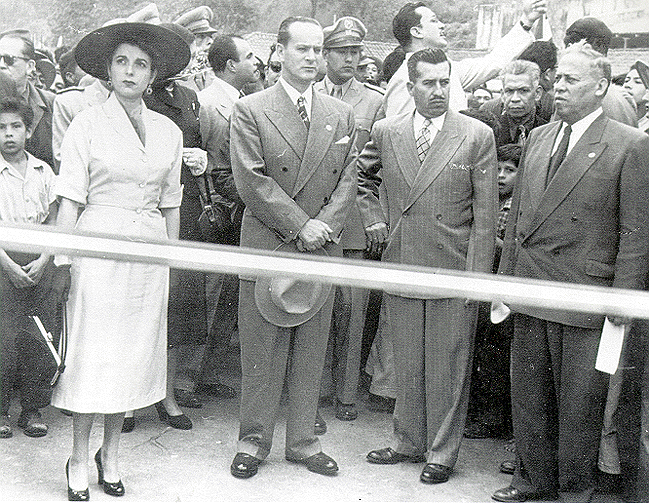
Source
The revolutionary government of president Jacobo Arbenz Guzman was the second democratically elected government of Guatemala after the revolution in 1944. Arbenz was an officer in the Guatemalan military and was a key figure during the revolutionary period. Arbenz served as president from 1951 to 1954 and is attributed with passing sweeping agrarian reform in Guatemala in support of workers and farmers.
Like many Central American countries, Guatemala's economy depended heavily on agriculture, and particularly on the export of coffee and bananas. By the 1940s United Fruit was the largest landowner in Guatemalan with substantial holdings throughout latin America.
Decree 900, aka the Land Reform Law, was passed into law by the Arbenz government in 1952 and aimed at redistributing unused land to Guatemala's peasant and indigenous population who had been marginalized since the Spanish conquest.
While the majority of Guatemalans celebrated the move towards socio-economic reorganization and autonomy, not everyone was pleased with the governments decision. For decades, the business of the United Fruit Company had profited immensely from access to cheap land, cheap labor of poor Guatemalans and an almost complete monopoly of the fruit business. Further consolidating its power, UFCo became the majority shareholder in the IRCA (International Railways of Central America), controlling the nation's railway system. At the same time, the company oversaw Guatemala's main seaport at Saint Barrios on the east coast.
Based on United Fruit's own tax filings which valued the company's land holdings at $2.99 per acre, the Guatemalan government offered to compensate UFCo at the same rate for a total of $ 1.85 million usd. UFCo executives were furious with what they considered an insulting underappreciation of the land demanding compensation at $19.5 million instead. Suddenly, the UFCo now valued the land at $75.00 per acre. In 1953, the Guatemalan government expropriated approximately 209,842 acres of United Fruits uncultivated land.
United Fruit increasingly saw the Arbenz's land reform act as an imminent threat to their business and a threat to their lofty position at the top of the Guatemalan food chain.
CIA Coup and the "International Communist Conspiracy"
In 1954, the CIA led a coup against the democratically elected government of Guatemala and installed a military dictatorship in its place that would control the country for the next 40 years.
At the time of the coup, the United States government denied any involvement in the coup while at the same time vociferously supporting the removal of the Arbenz administration.
In the following decades, the CIA and the USG openly admitted to their intimate involvement and would describe the overthrow as a necessary and decisive victory against the spread of the communist 'red infection' in Latin America. As the Eisenhower administration often portrayed the importance of denying communism a foothold in the Americas, it became the prototypical CIA operation success story.
Yet, evidence that communism in Guatemala posed any measurable threat to the United States, or to central America for that matter, was paltry and grossly overblown. By contrast, ample evidence suggests that covert US forces were ostensibly deployed at the behest of the United Fruit Company.
Over the course of several years starting in 1949, the UFCo launched an all-out public relations campaign to purge the region of the international communist conspiracy supposedly taking root inside Guatemala and within the Arbenz government.
Among several prominent figures hired by United Fruit, and charge with the development of the coordination of this PR campaign, was none-other than 'the father of Public Relations' Edward Bernays.
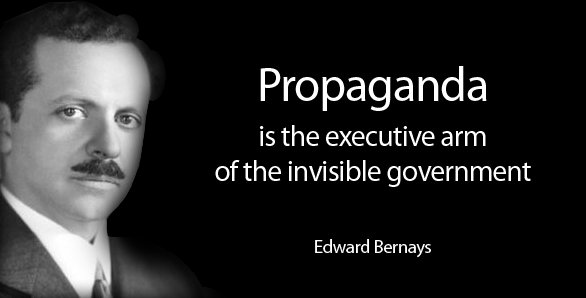
Source
According to Bernays, amplifying the threat of communism via a sustained campaign would build support for intervention and ultimately safeguard the interests of UFCo.
The reality on the ground in Guatemala was that, while a few communists held minor roles in the Arbenz coalition government, the communists had very little power or influence. Despite the grossly exaggerated claims brought forth the UFCo's top propagandists, in actuality politics of the Guatemalan revolution and the populist governments that followed were driven almost entirely by patriotic nationalism.
Now, with a PR campaign in full swing and a media cover story concocted to galvanize public support, the CIA moved forward with their preparations to remove the democratically elected government of Guatemala.
Operation PBFortune & PBSuccess
The first CIA operation aimed at arming rebels and the political enemies of the Arbenz government during the Truman administration was codenamed PBFortune.
The operation intended to deliver shipments of weapons to exiled Guatemalan army officer Carlos Castillo Armas. Armas was to stage an invasion with rebel forces from neighboring Nicaragua. The plan had the support of regional right-wing US-backed dictatorships of: Somoza in Nicaragua, Trujillo of the Dominican Republic, and Jiminez of Venezuela.
The operation was called off at the last minute when it was brought to the attention of the State Department and then Secretary of State Dean Acheson who feared an international backlash from US intervention would damage the image of the United States in latin America.
PBSuccess was the successor of PBFortune and finally saw the successful toppling of the Arbenz government in the 1954 coup.
Declassified documents released in 1997 reveal that CIA plots to oust Arbenz were in the making many years before the coup including discussions on the assassinating the Guatemalan president and high ranking officials.
“Guatemalan Communist Personnel to be disposed of during Military Operations”
https://nsarchive2.gwu.edu/NSAEBB/NSAEBB4/
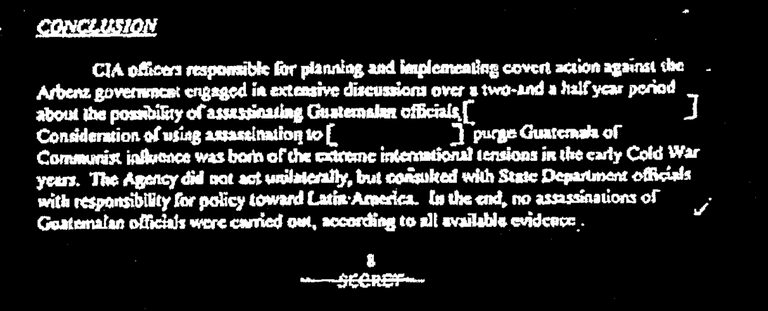
CIA officers responsible for planning and implementing covert action against the Arbenz government engaged in extensive discussion over a two-and a half year period about the possibility of assassinating Guatemalan officials [ redacted ]. Consideration of using assassination to [ redacted ] purge Guatemala of Communist influence was born of the extreme international tensions in the early Cold War years. The Agency did not act unilaterally, but consulted with State Department officials with responsibility for policy toward Latin America. In the end, no assassination of Guatemalan officials were carried out, according to all available evidence.
https://www.cia.gov/library/readingroom/docs/DOC_0005256960.pdf
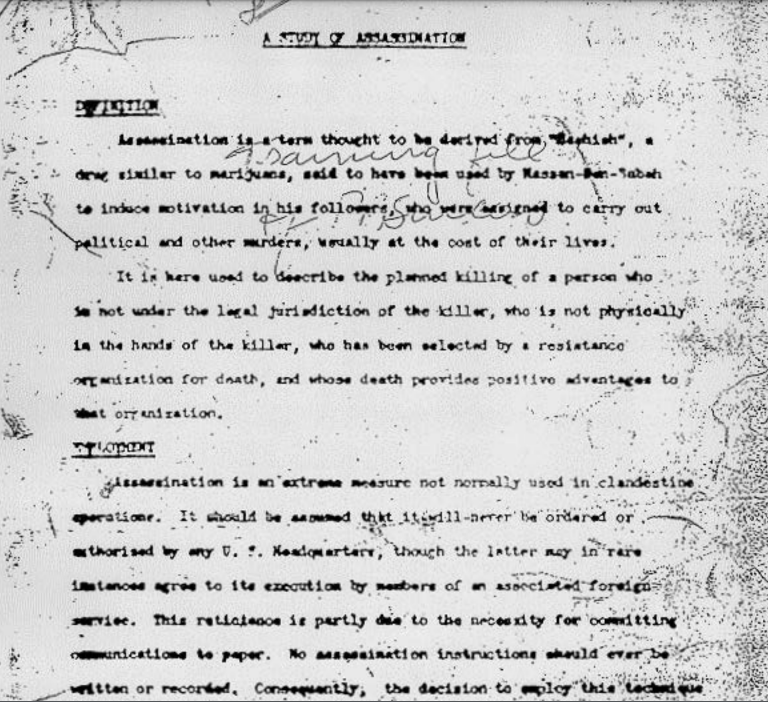
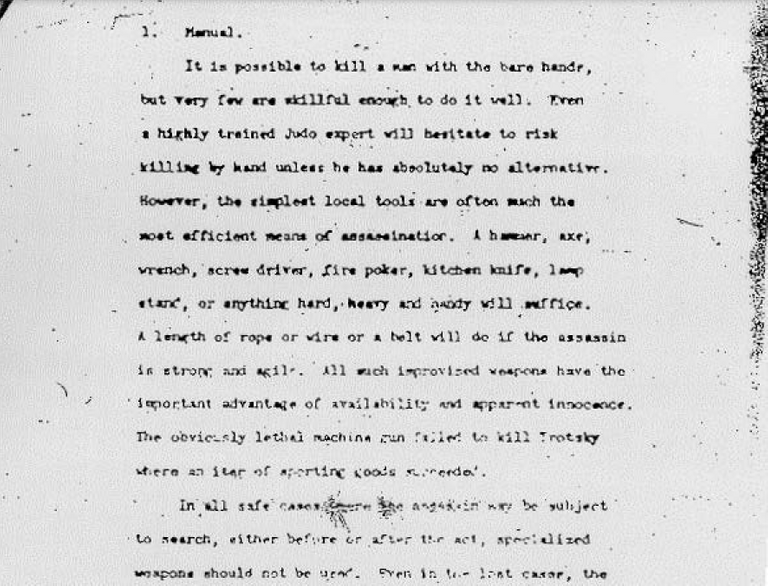
Assassination is an extreme measure not normally used in clandestine operations. It should be assumed that it will never be ordered or authorized by any US headquarters, though the latter may in rare instances agree to its execution by members of an associated foreign service.
This reticience is partly due to the necessity for committing communications to paper.
No assassination instructions should ever be written or recorded.
Full transcript of CIA Assassination Guide
https://nsarchive2.gwu.edu/NSAEBB/NSAEBB4/ciaguat2.html
* Note: Arbenz was not Assassinated, he surrendered and fled to Mexico
Coup Co-Conspirators
It's been well documented that prominent figures in the US government played a direct role in the 1954 Guatemalan coup. Active participants in the planning, financing and execution of the plot included the Dulles brothers, John and Allen, and an extensive list of statesmen, lobbyists and CIA operatives playing key roles to bring about the removal of the Arbenz government with operation PBSuccess.
At the core of the plot to overthrow Arbenz was the United Fruit Company who were terrified by the nationalist movement of the newly democratic country and the Agrarian reform that threatened their monopoly, profits, land holdings and the company's domination of the Guatemalan economy.
As fears among UFCo's executives grew in the early 1950s, then CEO Sam Zemurray sought the assistance of Washington insider Thomas Corcoran. With his extensive connections in DC, Corcoran was hired on to lobby government officials do intervene in Guatemala. Incidentally, Corcoran ran the infamous CIA front company - Civil Air Transport (CAT). Corcoran launched CAT in 1946 and entered into a formal agreement with the CIA in 1948 as part of covert operations.
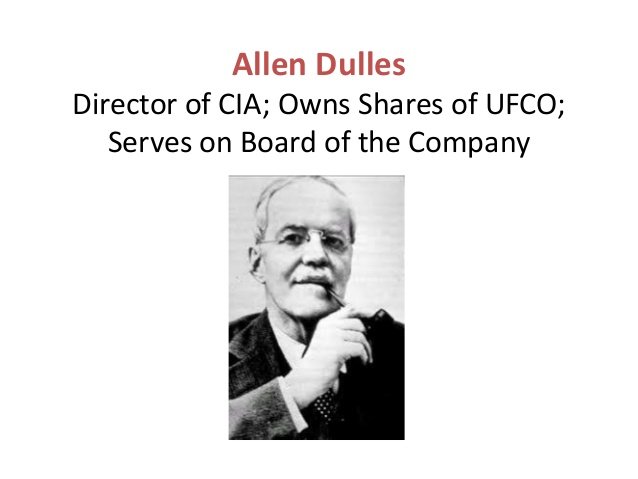
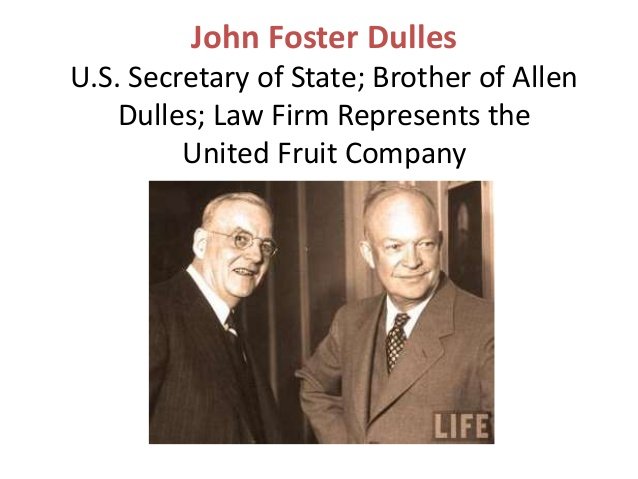
source
At the time of the Guatemalan coup, CIA Director Allen Dulles (1953-1961) was an old ally of in United Fruit Company. Earlier in his career, Allen Dulles served as a director of the Council on Foreign Relations (CFR) and was the Council's Secretary from 1933-1944.
His older brother, John Foster Dulles, was the sitting Secretary of State in 1954 and his Wall Street law firm, Sullivan and Cromwell, represented the United Fruit Company.
https://www.umbc.edu/che/tahlessons/pdf/historylabs/Guatemalan_Coup_student:RS01.pdf
A long list of characters throughout the United States Government had close ties to United Fruit which represented a genuine conflict of interest in the matter.
Cert Media
United Fruit and the Bananera Worker Massacre
Predating the Guatemalan coup by several decades, the UFCo was directly implicated in the massacre of hundreds of striking workers near the company's coastal plantations in Colombia.
UFCo activities in Colombia began in 1899 along the Caribbean coast in the remote areas of Santa Marta and Uraba in the Magdelena region. All the way back in 1928, United Fruit was involved in a massacre of 300 people as part of 10,000 striking workers in the small Columbian town of Cienaga just outside Santa Marta.
Employees of UFCo were among the main organizers of the mass demonstrations taking root throughout the region. The workers demanded nine improvements to their abysmal working conditions on the banana plantations:
- Stop their hiring practices through sub-contractors
- Mandatory collective insurance
- Compensation for work accidents
- Hygienic dormitories and 6 day work weeks
- Increase in daily pay for workers who earned less than 100 pesos per month
- Weekly wage
- Abolition of office stores
- Abolition of payment through coupons rather than money
- Improvement of hospital services
At the time, the strike was the largest labor movement Colombia had ever seen. Army troops were sent in from Bogota instead of from the local area of Magdalena for fear that local regiments wouldn't be able to contain the protestors who may also have familiar connections to the demonstrators.
Their demands were considerably modest: they did not want to be paid in coupons that could be used only at company stores, they did not want to live in extremely poor conditions at company shelters, and they wanted to unionize. Still, the company refused to negotiate, and the army was called in to solve the problem. An estimated 300 people were killed, but precise figures remain elusive. Soon after, the United Fruit Company (UFCo) decided that Colombia was too messy for it to operate there, and with no acknowledgement of the tragedy they had caused, the corporation left.
http://www.cpreview.org/blog/2007/05/chiquita-massacre
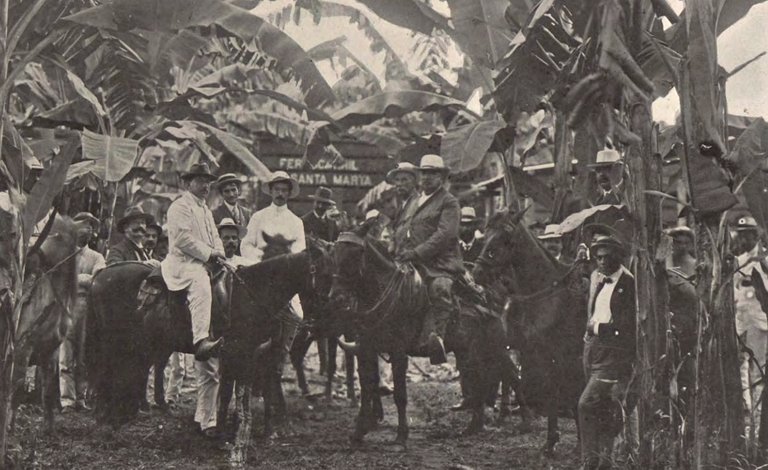
source
Much of the historic record on the exact events and the extent of UFCo's involvement in the massacre has been covered up or simply doesn't exist. Estimates of the dead range from 800-3000 striking workers. The story of the events of the 1928 workers strike has been preserved mainly through the oral history of the people of Santa Marta.
According to witnesses, on December 6th 1928 as people gathered in the city square of Cienaga awaiting an address by the governor after Sunday Mass, the military moved in. The gathering of workers also included women and children who had attended mass who were prevented from escaping the horror.
Government soldiers mounted machine guns on the roofs of low buildings of the town square and blocked access to the streets entering and exiting centre. The military gave a 5 minute warning and then opened fire on the defenseless civilians. It is believed that heaps of bodies were thrown into the sea or buried in unmarked mass graves by the military.
Official dispatches from the embassy in Bogota to Washington illustrate that the US government was aware of the strikes and to threats to UFCo and US interests in the region. Another telegram to Washington glowingly reports that it is their "honor to report" that representatives at UFCo estimate the number of killed by the military to exceed 1000 strike participants.
Dispatch from U.S. Bogatá Embassy to the US Secretary of State, dated December 5th, 1929, stated:
I have been following Santa Marta fruit strike through United Fruit Company representative here; also through Minister of Foreign Affairs who on Saturday told me government would send additional troops and would arrest all strike leaders and transport them to prison at Cartagena; that government would give adequate protection to American interests involved
Dispatch from U.S. Bogotá Embassy to the US Secretary of State, dated January 16, 1929, stated:
“
I have the honor to report that the Bogotá representative of the United Fruit Company told me yesterday that the total number of strikers killed by the Colombian military exceeded one thousand.
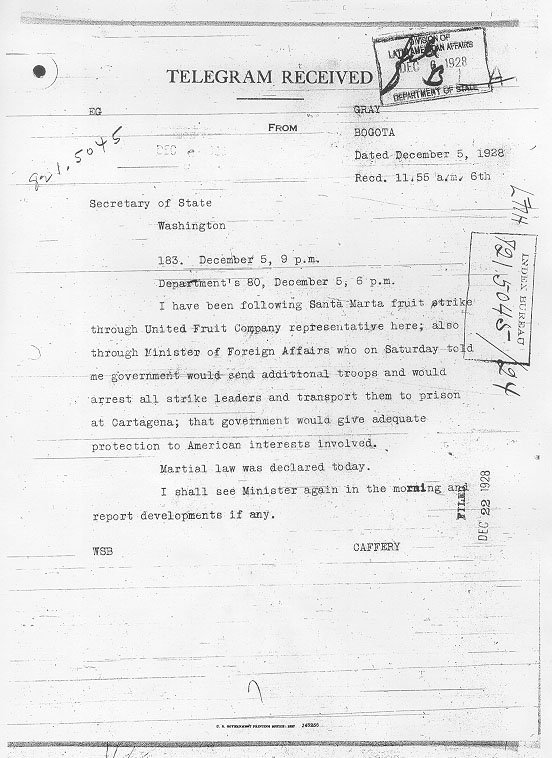
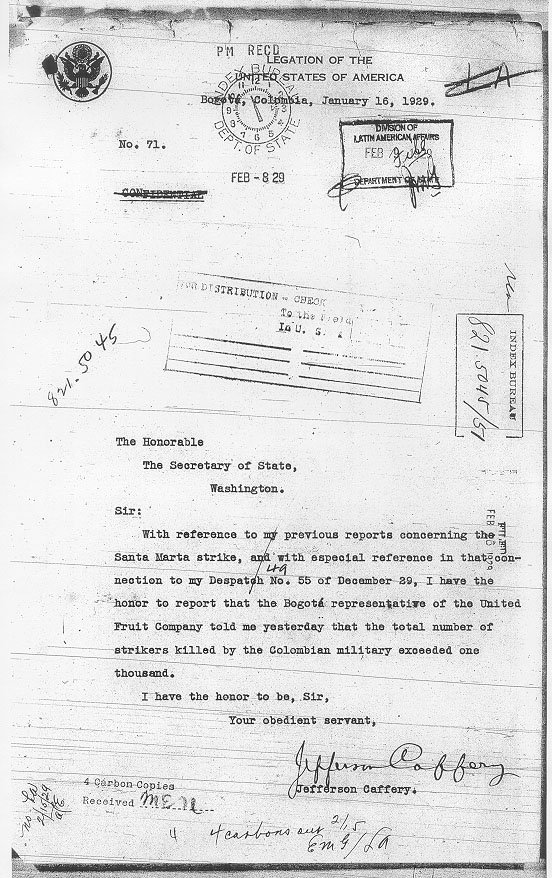
http://www.icdc.com/~paulwolf/colombia/santamarta.htm
United Fruit Company Rebrands, Becomes Chiquita
For the better part of a century, United Fruit enjoyed a virtual monopoly of the fruit industry. However, by the 1960s production was in decline, profits were down, a blight known as the Panama disease was destroying significant amounts of plantation crops and increased competition from regional exporters were taking its toll on the company.
Following the Guatemalan coup and a long history of violence and oppression, the United Fruit Company would become synonymous with Banana Republics.
Attempting to resuscitate the company's sinister image and move away from its association to coups, violence and corrupt regimes, UFCo first attempted to rebrand itself in 1970 as the United Brands Company merging with the meatpacking company AMK. Under new management, the fruit giant sought to diversify its business model by acquiring a number of acquisitions in the early 70s which included: Baskin Robbins and the A & W Rootbeer Company.
This was a rough period for the company as the competition from Dole and Standard Fruit ate into their market share and the company was in serious jeopardy by 1974. The combination of bad investments and mismanagement led to $70 million in losses in 1974.
In 1975, United Fruit made another attempt at rebranding to shake off the negative image that dogged the company in its association with the Banana Republics. That year, the company changed its name to the United Brands Company. However, revelations surfaced that the company was implicated in a string of bribery scandals in excess of a million dollars. In one instance, the Security and Exchange Commission (SEC) charged that United Brands had paid a $1.25 million dollar bribe of a Honduran official and promised another payment of $1.25 million in exchange for a reduction in export taxes.
Subsequently, the company was forced to rebrand itself once again in 1980. In that year, the company reimagined itself as the Chiquita Brands Company with the American company's headquarters being located in Cincinnati, Ohio.
In 1984, Carl Lindner who had been investing in United shares since the 1970s took over as the company's primary shareholder buying out the company's other major shareholders. With 87 percent of all shares Lindner named himself as the CEO of Chiquita and went to work selling off some of the company's expensive holdings and streamlining operations helping to return the company to prominence.
End of Part 1
There's no denying that UFCo/Chiquita has been a hugely successful American company for over a century. Equally, it's impossible to ignore the company built its empire off the backs the people of Central America through ruthless exploitation, rapacity, corruption, manipulation, land theft, propaganda, collusion with dictatorships, anti-democratic predilection, scandalous tax evasion, and military force.
Though the Guatemalan coup is perhaps the most well known instance of CIA regime change operations, it remains a critical study of western interventionism and the standard covert operations designed to topple governments.
In Part 2 & 3 we'll explore the actual coup, the roles of the co-conspirators in greater detail and the aftermath of dictatorial rule. Additionally, we'll explore Chiquita's more recent history and clear evidence of continued criminal activity involving terrorist organizations in Central and South America.
Sources
Bitter Fruit (1982) by by Stephen C. Schlesinger, Stephen Kinzer
https://spartacus-educational.com/JFKcorcoran.htm
https://www.cia.gov/library/center-for-the-study-of-intelligence/kent-csi/vol44no5/pdf/v44i5a03p.pdf
https://nsarchive2.gwu.edu/NSAEBB/NSAEBB4/
https://nsarchive2.gwu.edu/NSAEBB/NSAEBB4/ciaguat2.html
https://prwatch.org/news/2010/12/9834/banana-republic-once-again
https://scholarcommons.usf.edu/cgi/viewcontent.cgi?article=5942&context=etd
https://www.nytimes.com/1995/06/10/obituaries/thomas-cabot-98-capitalist-and-philanthropist-is-dead.html
https://www.commondreams.org/views/2019/11/13/coming-terms-us-role-central-america
http://www.cpreview.org/blog/2007/05/chiquita-massacre
http://www.icdc.com/~paulwolf/colombia/santamarta.htm
https://www.cia.gov/library/center-for-the-study-of-intelligence/kent-csi/vol44no5/html/v44i5a03p.htm
https://www.umbc.edu/che/tahlessons/pdf/historylabs/Guatemalan_Coup_student:RS01.pdf
http://www.scielo.org.co/scielo.php?pid=S1794-88862012000300003&script=sci_abstract&tlng=en


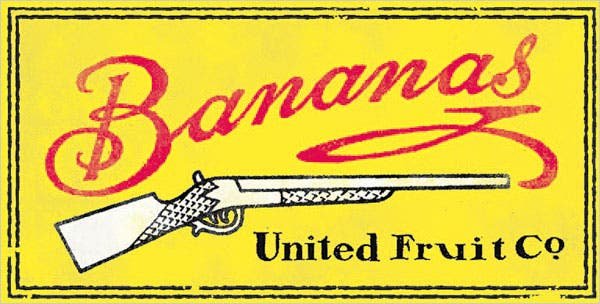
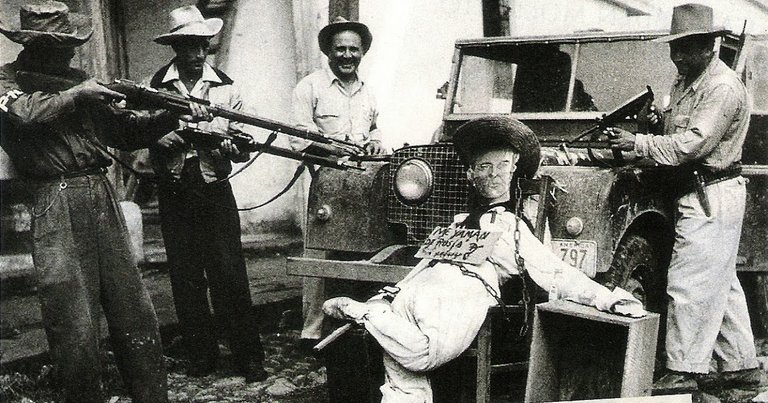
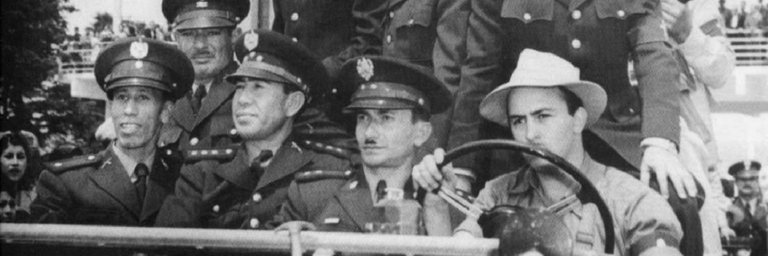
Well that's a piece of history I knew nothing about. Typical CIA spook BS, deny involvement in a conspiracy to depose a democratically elected leader and government, later admitted under the guise of "fighting evil" while it's all about "national interest", i.e. money and keeping the flow of resources (oil, bananas, etc.) into the imperial homeland. Same routine over and over, history repeats.
I think you are missing a dollar amount here:
Thanks for catching that!
I had to track it down but I found the the price per acreage.
There might be a few other mistakes in here. I need to go over it again asap to clean it up.
Happy to bring you a new story of gov/CIA/corporate corruption and criminal activity. You're absolutely right, this operation sets the stage for future regime change operations spearheaded by the intel community to protect 'national interests' / 'national security' / etc.
The operations evolve with whatever commodity is the most lucrative at the that particular time: Bananas -> Minerals -> Oil -> Data
!ENGAGE 25
ENGAGEtokens.@zyxx recommended that I come read this, and I am so glad I did. While I am aware of this activity on the part of corporations and the CIA, with cooperation and support from POTUS administrations, to have the facts all in one place like this makes my suspicions clear. These people are more malicious than I could have imagined without information like all this. That list of names!!!! Thank you so much for doing this work. I look forward to parts 2 and 3, and hope you do get a chance to produce them.
Thanks for taking the time to read it and to @zyx066 for recommending it. I intended to post the follow ups but have been having some writers block this year and with stories like these they tend to keep expanding the more you look into them.
The list of names is fascinating, isn't it?
The Dulles brothers especially deserve a closer examination. If you keep following the breadcrumbs you'll discover that they represented Wall Street interests in doing business with nazi industrialists right up until the end of WWII. When stationed in Switzerland to lead the OSS intelligence effort, Allen Dulles was in close contact with nazi party members and even met with high ranking party officials. Ivy-league educated Dulles admired the nazis and failed to include mention of their crimes against humanity at the concentration camps in his reports to the State Department while leading intel operations in Europe. Many believed he concealed the extent of nazi crimes in order to keep America out of the war and maintain lucrative business alliances with nazi industrialists. Dulles actively shielded nazis from prosecution and was focused entirely on how to control and profit from post war Europe. A treasonous American elitist to say the least.
Thank you for many things, especially spelling @zyx066 correctly so that he knows I appreciate him! We are all walking each other into love, no matter our differences.
Dulles neglected to include the nazi crimes (why must I capitalze nazi? Is it not yet a thing that doesn't need to be honored as a proper noun?!) because we have been conditioned to believe they were simple nazi crimes. In fact, they were a set up for today's crimes, among many other set ups. If I try to draw parallels between what is happening today with what was happening then, Jews everywhere pour hate down on me. It was a brilliant move for the eugenicists to write history so that the Jews were the star of the WWII show. Oh, that is a very long conversation~
So what descendants of Dulles are active today? I know there has been a more recent Dulles than these two. I'll go look that up now.
I did read the whole thing and am looking forward to the next instalment.
It's a really interesting story and but sadly holds no surprises or shocks. Another example of capitalist extremes, manifesting into extreme greed and the use of violence and subterfuge to manipulate and control the flow of wealth to the few, from the many. As someone who sits somewhat ashamedly in a central position on the political spectrum, with a shoulder that sags slightly to the left, the futility in searching for balance in all walks of life drags me down.
For me, the key is attempting to understand the driving force behind the powerful's never-ending quest for more. More power, more money, more control. I am simply unable to comprehend that level of blinkered, single-mindedness that propels people to strive for a personal goal of having absolute power over everyone else using whatever tools they have at their disposal and no matter the human cost, and of course, the actual, physical wealth that surely accompanies that power.
I know I always compliment you on your writing and of course, this remains true but I do find myself wishing, that in a harrowing tale such as this, you'd put a little of yourself into it instead of your dogged determination to tell the story and allow your reader to completely come to their own opinions, and with that end in mind, may I suggest after Part 3, you write an opinion piece as a follow up? please?!
Thank you and as always, I hope you're staying safe and sane throughout the current climate.
Best wishes :-)
!ENGAGE 25
ENGAGEtokens.Thanks for taking the time to read it all, it's a lot to absorb.
I agree that the mindset to acquire more power, wealth and control is hard to comprehend outside of pure pyschopathy.
Thanks for the kind words, I appreciate it very much.
As for my writing style, it is what it is. However, in the follow up posts on this I may add my own two cents and discuss the implications of the events.
I can neither confirm nor deny at this time ;)
Is Santa bringing me a new bike for Christmas or not? LOL...I wouldn't have it any other way!
Wow. Thanks so much for this thoroughly enlightening read my friend. Never knew that the father of propaganda, Bernays, was involved with this whole mess, nor did I have a good understanding of how cruel UFCo was in their reign of the region; I didn't know about the brutal massacre of demonstrators for example... After reading this I eagerly browsed the rest of your blog in search of part 2, but I guess we'll just have to be patient for another piece of such depth and detail... Thanks for your hard work and dedication @v4vapid!
It also surprised me as well that the United Fruit employed Bernays and that he developed the narrative that eventually lead to the coup.
This narrative of a communist conspiracy to take over the United States is alive and well toady.
Coffee spurts from my nose every time I read some in the alternative media who consistently refer to Biden as a communist! Are you fucking joking me?! No, apparently they are completely serious about this.
It takes a special, and colossal, type of denial to pretend that Biden is anything other than a corporate capitalist puppet and Patriot Act writing warmonger.
I was hoping to pen part 2 but I've had some writers block. Hopefully, I'll finally breakthrough and share the rest of my research with everyone sometime soon. Thanks for taking the time to read my piece, it's a bit of a slog so I'm happy if anyone invests the time in it. Cheers!
I had no clue about the Chiquita Banana conspiracies... but did you heard about the Dutch cheese fraud? 🤣 LOL, great article, didn't read the whole thing but interesting, saving databanks for my topics. 🤓 Seems accurate for this planet though, maybe we could start classifying this as "normal" in staid of conspiracy theory 🤣 Since anyone who studies history must see this trend. But the 21st century is different, if we can get by this Corona Crime Against Humanity, I think we will do alright, maybe get back leadership and real democracy.
On a side-note, the long banana's we have grown up to like are the most hybrid banana's and the least nutritious for you, may be acidic thus toxic for our cells. US company? Probably made on Windows GMO.
ENGAGEtokens.!ENGAGE 25
Absolutely amazing write up of one of the earliest screw-ups that document one of the worst agencies the United States ever had.
The connections here then lead on into the future for drug running and more shady business and then into the late 70s and 80s along with cocaine.
However back then you could still buy all sorts of products made with these which would be an interesting write-up...
If you start doing the early CIA involvement in the drug war definitely tag me and harass me very interested in your further works as well.
Phenomenal job amazing sources and all in all really important information that people should understand.
Thanks, yes the CIA-drug connections are mind blowing. Gary Webb's investigation with Dark Alliance is just one incredible example of a massive CIA sponsored drug operation throughout the US and funding death squads and regime change operations in Nicaragua. Vietnam war and drug trafficking is also something that comes to mind...
Maybe we'll do a #deepdives challenge on Drug Trafficking in the future! could be a fun one. Thanks for taking the time for commenting on the piece, always nice to get some positive feedback. Cheers.
You absolutely cannot talk about Gary Webb.
Or freeway Ricky Ross.
or the fact that Gary Webb shot himself twice in the head to commit suicide...
Actually I double dog dare you...
Absolutely man I really can't wait.
My personal favorite is air America in Laos during the Vietnam war...
Or how about George jung, barry seals?
Yeah some wild people back then.
Wow I had no idea about this link between Chiquita bananas and the CIA-backed coup. Though sadly not all that surprising given the relations between most western corporations and western imperial foreign policy. Just one of many examples of the post-colonial western colonialist policies still dominating the geopolitical reality of the world today... And one I would imagine is lesser known than many others.
Yes, this sort of thing has been going on for a long, long time. I think people have heard something about United Fruit and Guatemala but are unaware that Chiquita is a rebrand. The extent of the CIA/USG involvement in removing a democratically elected government at the behest of corporate interests is quite shocking though. Thanks for taking the time to check it out.
These people love money and control too much. Crazy and sick!
!ENGAGE 25
ENGAGEtokens.These people are nasty
I don’t often save Hive content to my Instapaper but I just did. In fact, you have the honor of being the first one.
Thank you for the link, it's a big part of the story!
Appreciate the reblogs, retweets and good words.
It's an honor to be the first Hive piece you've shared to the outside world.
Chock full of a potassium of information. 😁🍌
Harry Belafonte and Carmen Miranda were both influencial pop culture icons who raised the appeal of the banana. They made yellow sexy.
One thing that always discouraged me is how the original banana became extinct. Historically, did manufacturers try to cover up this juicy morsel of information? It might have made their product look a bit green. The variety we now eat is a completely different banana and flavor. The lost original is the unicorn of fruit as far as I am concerned.
This research article makes me wonder if greed was a major factor in how the popular version of the banana nearly disappeared forever. It must have been bigger than a mismanagement lack of foresight to misunderstand how to maintain the gold standard identity of the product.
you haven't posted about corona, have you?
the topic is probably too obvious (handsinfrontofapeface)
Here you go.
Superbly researched and cited, this post is exemplary of the revelations I have come to expect from you, and of the kind of work I seek to emulate.
Bitter Fruit indeed.
Thanks!
Thanks so much, if you're interested in learning more check out the book Bitter Fruit it's worth reading. I linked to an archived copy in the sources. I reread it recently and it's very instructive in light of regime change ops going on right now. Hope you're well!
I am better than expected, more hopeful than I should be.
I have long known about UFC, the CIA, and Arbenz, but you filled in many details I was unaware of and particularly names of individuals involved. I had been unaware of the Colombian strikes and the many lives lost there in connection with UFC. I am deeply grateful for your careful and exhaustive research.
Bloody bananas! You got this...
Probably a better title!
I was transfixed by this research!
Rule by force is the disease, who and how are symptoms.
I’m looking forward in the next update
roles of the co-conspirators in greater detail
I've got a loaded papaya and I'm not afraid to use it!
That Allen Dulles has a lot to answer for?
Wow! That was intense and a massive piece of history.....I get my banana shake now 😉
Congratulations @v4vapid! You have completed the following achievement on the Hive blockchain and have been rewarded with new badge(s) :
You can view your badges on your board and compare yourself to others in the Ranking
If you no longer want to receive notifications, reply to this comment with the word
STOPDo not miss the last post from @hivebuzz:
I must always stand behind and support my colleagues and wish you success. Providence help you in your work, you see my sincere wish. Always in touch. Merry and blessed Christmas, a beautiful future awaits us, it is our hope. Successes
I am very motivated with you, for your constant positive evaluations of my publications. Thank you. God will always be with you. Hugs from Venezuela. Success for you is my sincere wish this Christmas.
Lovely article
wow, I just had to check out this post.. what a great title! :P
banana salad? really?? sounds yummy.
thanks for showing me such entertaining vid! 😉😎🤙